PROJ 6008: Leadership for Contemporary Organizations - Bill Gates
VerifiedAdded on 2022/11/03
|10
|2630
|415
Report
AI Summary
This report examines the leadership of Bill Gates, focusing on his skills, characteristics, and the evolution of his leadership style within Microsoft. It explores his initial autocratic approach and subsequent shift towards democratic and transformational leadership, analyzing the reasons behind these changes, including the impact of business setbacks and the need to adapt to a changing workforce and market dynamics. The report delves into Gates' ability to predict future trends, make rapid decisions, and foster employee engagement, highlighting the importance of his leadership in Microsoft's success. It also discusses his leadership methods, approaches, and the impact of his leadership on organizational culture and employee involvement. The analysis includes references to the assignment brief provided and offers a comprehensive understanding of Gates' influence on the organization and his adaptation to contemporary leadership challenges.
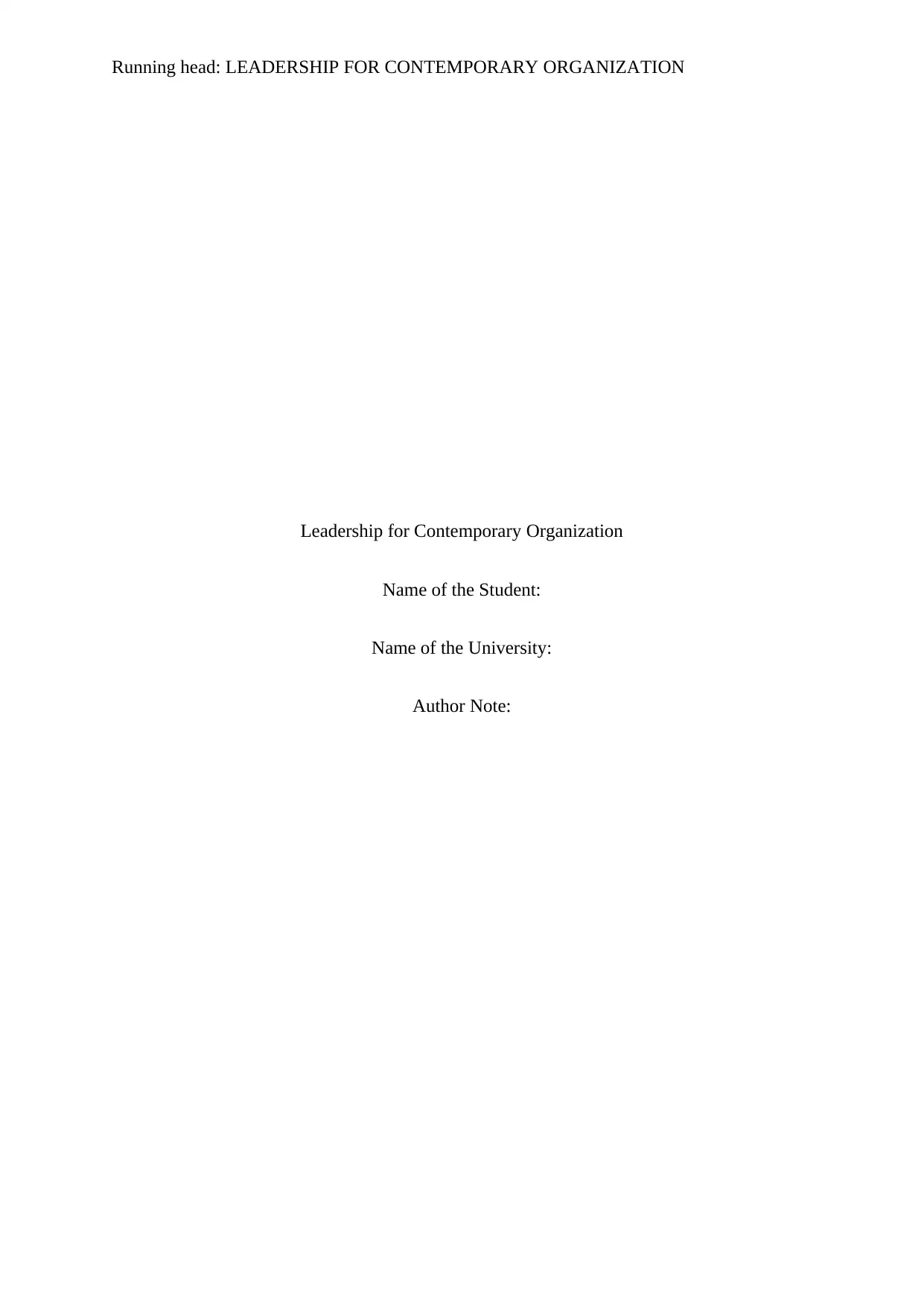
Running head: LEADERSHIP FOR CONTEMPORARY ORGANIZATION
Leadership for Contemporary Organization
Name of the Student:
Name of the University:
Author Note:
Leadership for Contemporary Organization
Name of the Student:
Name of the University:
Author Note:
Paraphrase This Document
Need a fresh take? Get an instant paraphrase of this document with our AI Paraphraser

1LEADERSHIP FOR CONTEMPORARY ORGANIZATION
Table of Contents
Introduction................................................................................................................................2
Discussion..................................................................................................................................2
Leadership of Bill Gates: Skill, Characteristics and Knowledge...........................................2
Reason for Change in Leadership Style.................................................................................4
How and When did Bill Gates Learn the New Leadership Styles.........................................5
Leadership Method, Approach and Concept of Bill Gates....................................................6
Conclusion..................................................................................................................................7
References..................................................................................................................................8
Table of Contents
Introduction................................................................................................................................2
Discussion..................................................................................................................................2
Leadership of Bill Gates: Skill, Characteristics and Knowledge...........................................2
Reason for Change in Leadership Style.................................................................................4
How and When did Bill Gates Learn the New Leadership Styles.........................................5
Leadership Method, Approach and Concept of Bill Gates....................................................6
Conclusion..................................................................................................................................7
References..................................................................................................................................8
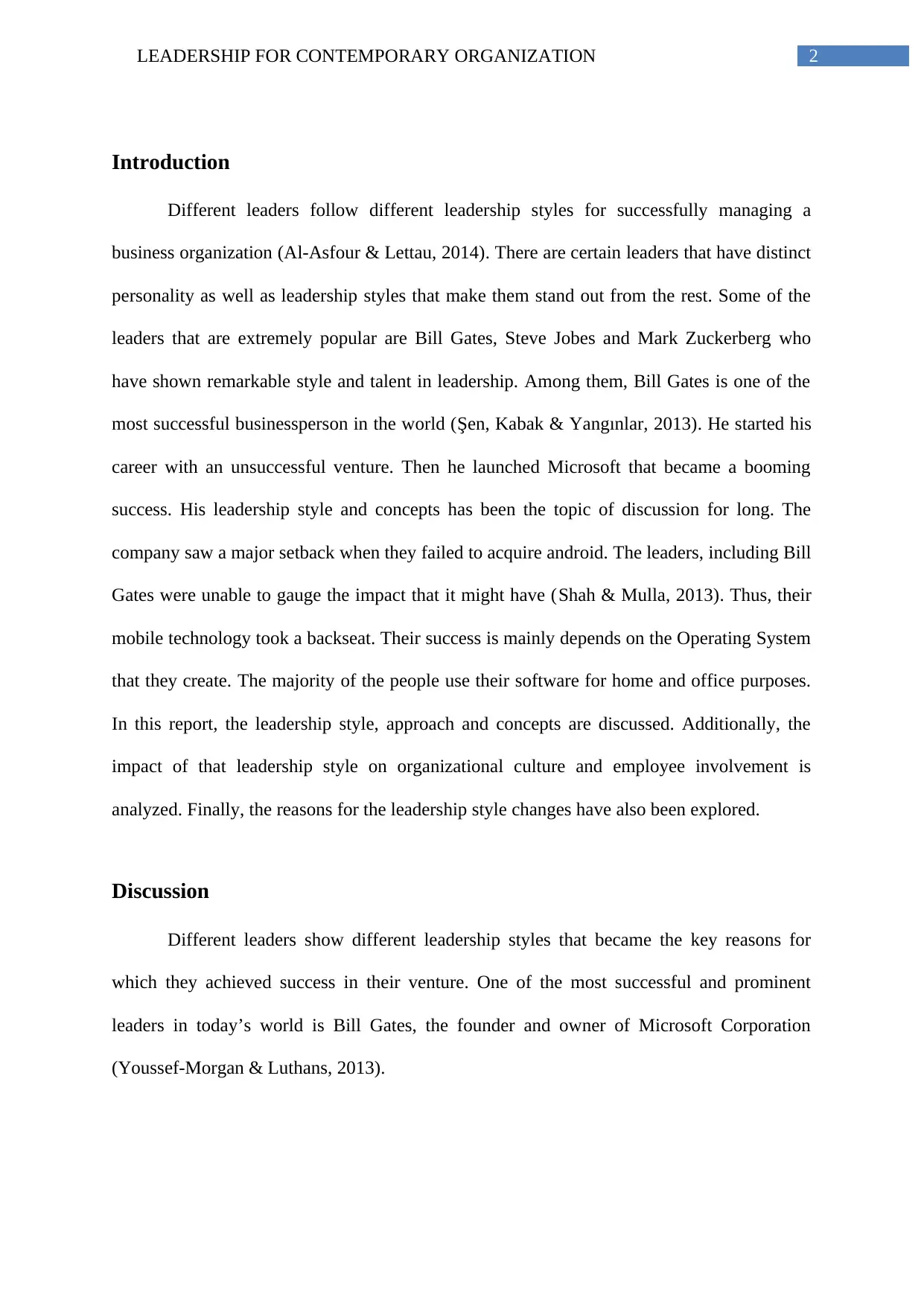
2LEADERSHIP FOR CONTEMPORARY ORGANIZATION
Introduction
Different leaders follow different leadership styles for successfully managing a
business organization (Al-Asfour & Lettau, 2014). There are certain leaders that have distinct
personality as well as leadership styles that make them stand out from the rest. Some of the
leaders that are extremely popular are Bill Gates, Steve Jobes and Mark Zuckerberg who
have shown remarkable style and talent in leadership. Among them, Bill Gates is one of the
most successful businessperson in the world (Şen, Kabak & Yangınlar, 2013). He started his
career with an unsuccessful venture. Then he launched Microsoft that became a booming
success. His leadership style and concepts has been the topic of discussion for long. The
company saw a major setback when they failed to acquire android. The leaders, including Bill
Gates were unable to gauge the impact that it might have (Shah & Mulla, 2013). Thus, their
mobile technology took a backseat. Their success is mainly depends on the Operating System
that they create. The majority of the people use their software for home and office purposes.
In this report, the leadership style, approach and concepts are discussed. Additionally, the
impact of that leadership style on organizational culture and employee involvement is
analyzed. Finally, the reasons for the leadership style changes have also been explored.
Discussion
Different leaders show different leadership styles that became the key reasons for
which they achieved success in their venture. One of the most successful and prominent
leaders in today’s world is Bill Gates, the founder and owner of Microsoft Corporation
(Youssef-Morgan & Luthans, 2013).
Introduction
Different leaders follow different leadership styles for successfully managing a
business organization (Al-Asfour & Lettau, 2014). There are certain leaders that have distinct
personality as well as leadership styles that make them stand out from the rest. Some of the
leaders that are extremely popular are Bill Gates, Steve Jobes and Mark Zuckerberg who
have shown remarkable style and talent in leadership. Among them, Bill Gates is one of the
most successful businessperson in the world (Şen, Kabak & Yangınlar, 2013). He started his
career with an unsuccessful venture. Then he launched Microsoft that became a booming
success. His leadership style and concepts has been the topic of discussion for long. The
company saw a major setback when they failed to acquire android. The leaders, including Bill
Gates were unable to gauge the impact that it might have (Shah & Mulla, 2013). Thus, their
mobile technology took a backseat. Their success is mainly depends on the Operating System
that they create. The majority of the people use their software for home and office purposes.
In this report, the leadership style, approach and concepts are discussed. Additionally, the
impact of that leadership style on organizational culture and employee involvement is
analyzed. Finally, the reasons for the leadership style changes have also been explored.
Discussion
Different leaders show different leadership styles that became the key reasons for
which they achieved success in their venture. One of the most successful and prominent
leaders in today’s world is Bill Gates, the founder and owner of Microsoft Corporation
(Youssef-Morgan & Luthans, 2013).
⊘ This is a preview!⊘
Do you want full access?
Subscribe today to unlock all pages.

Trusted by 1+ million students worldwide
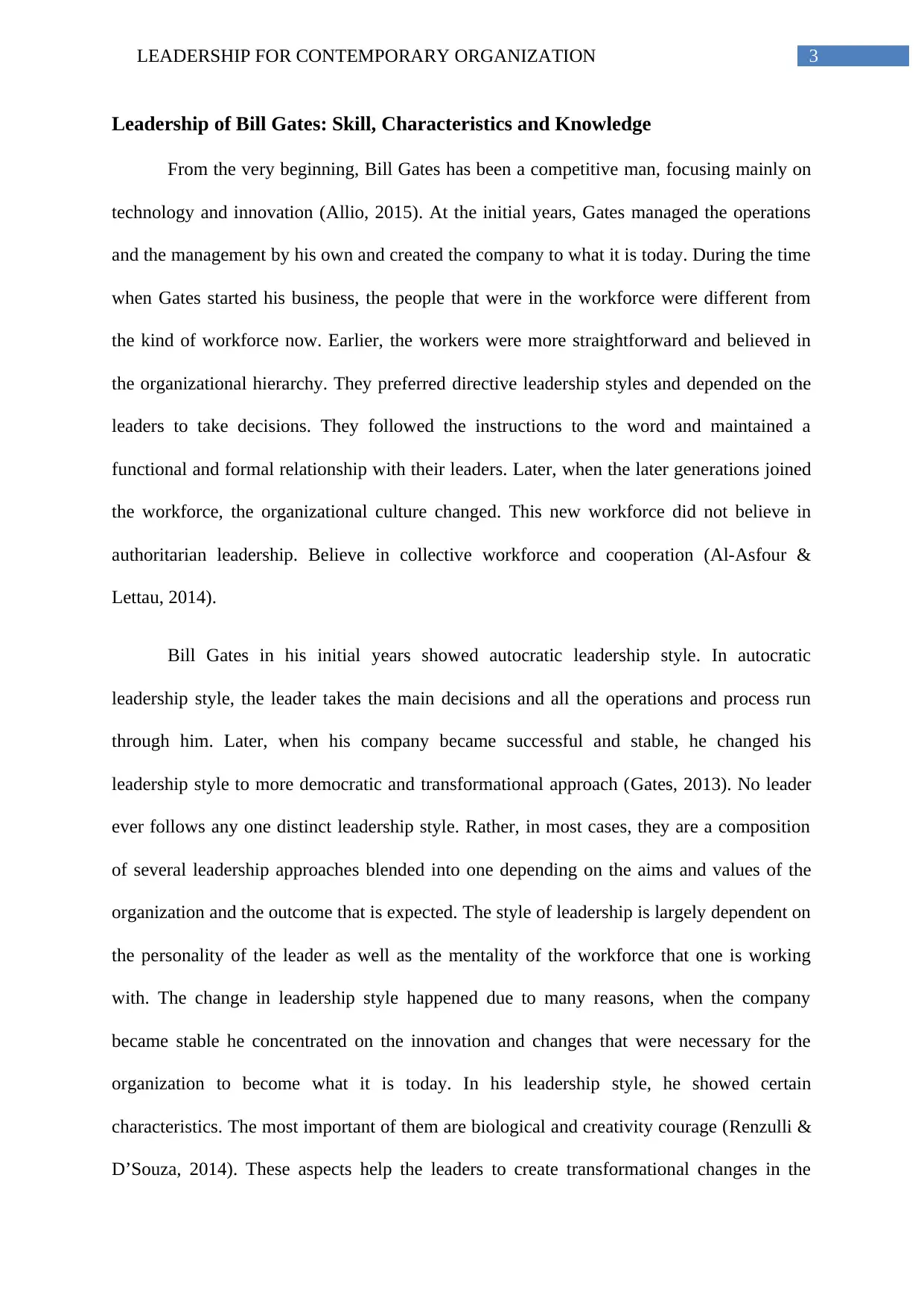
3LEADERSHIP FOR CONTEMPORARY ORGANIZATION
Leadership of Bill Gates: Skill, Characteristics and Knowledge
From the very beginning, Bill Gates has been a competitive man, focusing mainly on
technology and innovation (Allio, 2015). At the initial years, Gates managed the operations
and the management by his own and created the company to what it is today. During the time
when Gates started his business, the people that were in the workforce were different from
the kind of workforce now. Earlier, the workers were more straightforward and believed in
the organizational hierarchy. They preferred directive leadership styles and depended on the
leaders to take decisions. They followed the instructions to the word and maintained a
functional and formal relationship with their leaders. Later, when the later generations joined
the workforce, the organizational culture changed. This new workforce did not believe in
authoritarian leadership. Believe in collective workforce and cooperation (Al-Asfour &
Lettau, 2014).
Bill Gates in his initial years showed autocratic leadership style. In autocratic
leadership style, the leader takes the main decisions and all the operations and process run
through him. Later, when his company became successful and stable, he changed his
leadership style to more democratic and transformational approach (Gates, 2013). No leader
ever follows any one distinct leadership style. Rather, in most cases, they are a composition
of several leadership approaches blended into one depending on the aims and values of the
organization and the outcome that is expected. The style of leadership is largely dependent on
the personality of the leader as well as the mentality of the workforce that one is working
with. The change in leadership style happened due to many reasons, when the company
became stable he concentrated on the innovation and changes that were necessary for the
organization to become what it is today. In his leadership style, he showed certain
characteristics. The most important of them are biological and creativity courage (Renzulli &
D’Souza, 2014). These aspects help the leaders to create transformational changes in the
Leadership of Bill Gates: Skill, Characteristics and Knowledge
From the very beginning, Bill Gates has been a competitive man, focusing mainly on
technology and innovation (Allio, 2015). At the initial years, Gates managed the operations
and the management by his own and created the company to what it is today. During the time
when Gates started his business, the people that were in the workforce were different from
the kind of workforce now. Earlier, the workers were more straightforward and believed in
the organizational hierarchy. They preferred directive leadership styles and depended on the
leaders to take decisions. They followed the instructions to the word and maintained a
functional and formal relationship with their leaders. Later, when the later generations joined
the workforce, the organizational culture changed. This new workforce did not believe in
authoritarian leadership. Believe in collective workforce and cooperation (Al-Asfour &
Lettau, 2014).
Bill Gates in his initial years showed autocratic leadership style. In autocratic
leadership style, the leader takes the main decisions and all the operations and process run
through him. Later, when his company became successful and stable, he changed his
leadership style to more democratic and transformational approach (Gates, 2013). No leader
ever follows any one distinct leadership style. Rather, in most cases, they are a composition
of several leadership approaches blended into one depending on the aims and values of the
organization and the outcome that is expected. The style of leadership is largely dependent on
the personality of the leader as well as the mentality of the workforce that one is working
with. The change in leadership style happened due to many reasons, when the company
became stable he concentrated on the innovation and changes that were necessary for the
organization to become what it is today. In his leadership style, he showed certain
characteristics. The most important of them are biological and creativity courage (Renzulli &
D’Souza, 2014). These aspects help the leaders to create transformational changes in the
Paraphrase This Document
Need a fresh take? Get an instant paraphrase of this document with our AI Paraphraser
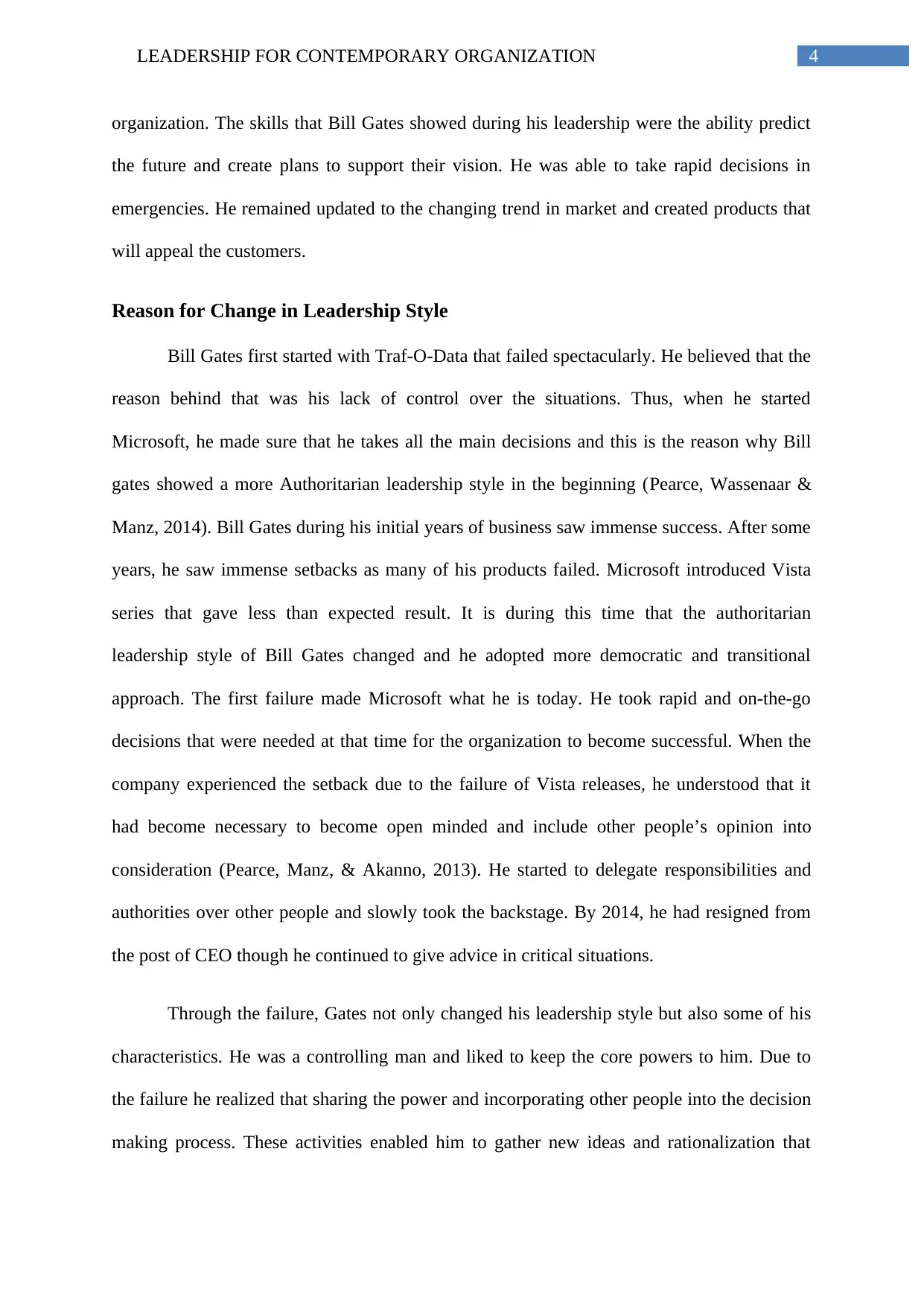
4LEADERSHIP FOR CONTEMPORARY ORGANIZATION
organization. The skills that Bill Gates showed during his leadership were the ability predict
the future and create plans to support their vision. He was able to take rapid decisions in
emergencies. He remained updated to the changing trend in market and created products that
will appeal the customers.
Reason for Change in Leadership Style
Bill Gates first started with Traf-O-Data that failed spectacularly. He believed that the
reason behind that was his lack of control over the situations. Thus, when he started
Microsoft, he made sure that he takes all the main decisions and this is the reason why Bill
gates showed a more Authoritarian leadership style in the beginning (Pearce, Wassenaar &
Manz, 2014). Bill Gates during his initial years of business saw immense success. After some
years, he saw immense setbacks as many of his products failed. Microsoft introduced Vista
series that gave less than expected result. It is during this time that the authoritarian
leadership style of Bill Gates changed and he adopted more democratic and transitional
approach. The first failure made Microsoft what he is today. He took rapid and on-the-go
decisions that were needed at that time for the organization to become successful. When the
company experienced the setback due to the failure of Vista releases, he understood that it
had become necessary to become open minded and include other people’s opinion into
consideration (Pearce, Manz, & Akanno, 2013). He started to delegate responsibilities and
authorities over other people and slowly took the backstage. By 2014, he had resigned from
the post of CEO though he continued to give advice in critical situations.
Through the failure, Gates not only changed his leadership style but also some of his
characteristics. He was a controlling man and liked to keep the core powers to him. Due to
the failure he realized that sharing the power and incorporating other people into the decision
making process. These activities enabled him to gather new ideas and rationalization that
organization. The skills that Bill Gates showed during his leadership were the ability predict
the future and create plans to support their vision. He was able to take rapid decisions in
emergencies. He remained updated to the changing trend in market and created products that
will appeal the customers.
Reason for Change in Leadership Style
Bill Gates first started with Traf-O-Data that failed spectacularly. He believed that the
reason behind that was his lack of control over the situations. Thus, when he started
Microsoft, he made sure that he takes all the main decisions and this is the reason why Bill
gates showed a more Authoritarian leadership style in the beginning (Pearce, Wassenaar &
Manz, 2014). Bill Gates during his initial years of business saw immense success. After some
years, he saw immense setbacks as many of his products failed. Microsoft introduced Vista
series that gave less than expected result. It is during this time that the authoritarian
leadership style of Bill Gates changed and he adopted more democratic and transitional
approach. The first failure made Microsoft what he is today. He took rapid and on-the-go
decisions that were needed at that time for the organization to become successful. When the
company experienced the setback due to the failure of Vista releases, he understood that it
had become necessary to become open minded and include other people’s opinion into
consideration (Pearce, Manz, & Akanno, 2013). He started to delegate responsibilities and
authorities over other people and slowly took the backstage. By 2014, he had resigned from
the post of CEO though he continued to give advice in critical situations.
Through the failure, Gates not only changed his leadership style but also some of his
characteristics. He was a controlling man and liked to keep the core powers to him. Due to
the failure he realized that sharing the power and incorporating other people into the decision
making process. These activities enabled him to gather new ideas and rationalization that

5LEADERSHIP FOR CONTEMPORARY ORGANIZATION
helped him take decision that is more informed and made him rely on people that were able
(Goleman, 2013). Another failure that Gates himself had acknowledged repeatedly is the
failure to acquire android. Android technology has revolutionized the mobile technology.
When android came to the market, Microsoft could not foresee the impact that it might have
and thus Google was able to acquire it. The importance of Microsoft mobiles reduces
significantly after that as android took over the market. This is one mistake that the company
has not been able to overcome till date. Presently, the Apple and Android has completely
captured the market and Microsoft mainly operates in the PC Operating systems (Eragula,
2015).
How and When did Bill Gates Learn the New Leadership Styles
Any noticeable change in any organization comes when any significant drawbacks
take place (Malewska & Sajdak, 2014). For Microsoft, that drawback came with their failure
of Vista releases. Vista was created as premium software. It proved to be too heavy for the
PCs and many systems crashed. Moreover, it required all licensed software to be installed
that led to it subsequent unpopularity. This is when Gates realized that he had to change his
method. When he started his business, people had different needs and requirements when it
came to PCs. With change in time, people wanted lighter and more user-friendly software
that would give them more freedom to install applications as per their necessity. When Vista
failed to do that, many Microsoft users opted for Ubuntu, Linux or Unix Operating system
thus decreasing the sales of Microsoft significantly. He slowly started to incorporate others
into the decision- making (Fejerskov, 2015). He created a board that will engage in intense
discussion about important scenarios and will brainstorm ideas before any final decision
regarding a product is taken. This enabled him to choose from an array of several ideas and
suggestions and test them before launch.
helped him take decision that is more informed and made him rely on people that were able
(Goleman, 2013). Another failure that Gates himself had acknowledged repeatedly is the
failure to acquire android. Android technology has revolutionized the mobile technology.
When android came to the market, Microsoft could not foresee the impact that it might have
and thus Google was able to acquire it. The importance of Microsoft mobiles reduces
significantly after that as android took over the market. This is one mistake that the company
has not been able to overcome till date. Presently, the Apple and Android has completely
captured the market and Microsoft mainly operates in the PC Operating systems (Eragula,
2015).
How and When did Bill Gates Learn the New Leadership Styles
Any noticeable change in any organization comes when any significant drawbacks
take place (Malewska & Sajdak, 2014). For Microsoft, that drawback came with their failure
of Vista releases. Vista was created as premium software. It proved to be too heavy for the
PCs and many systems crashed. Moreover, it required all licensed software to be installed
that led to it subsequent unpopularity. This is when Gates realized that he had to change his
method. When he started his business, people had different needs and requirements when it
came to PCs. With change in time, people wanted lighter and more user-friendly software
that would give them more freedom to install applications as per their necessity. When Vista
failed to do that, many Microsoft users opted for Ubuntu, Linux or Unix Operating system
thus decreasing the sales of Microsoft significantly. He slowly started to incorporate others
into the decision- making (Fejerskov, 2015). He created a board that will engage in intense
discussion about important scenarios and will brainstorm ideas before any final decision
regarding a product is taken. This enabled him to choose from an array of several ideas and
suggestions and test them before launch.
⊘ This is a preview!⊘
Do you want full access?
Subscribe today to unlock all pages.

Trusted by 1+ million students worldwide
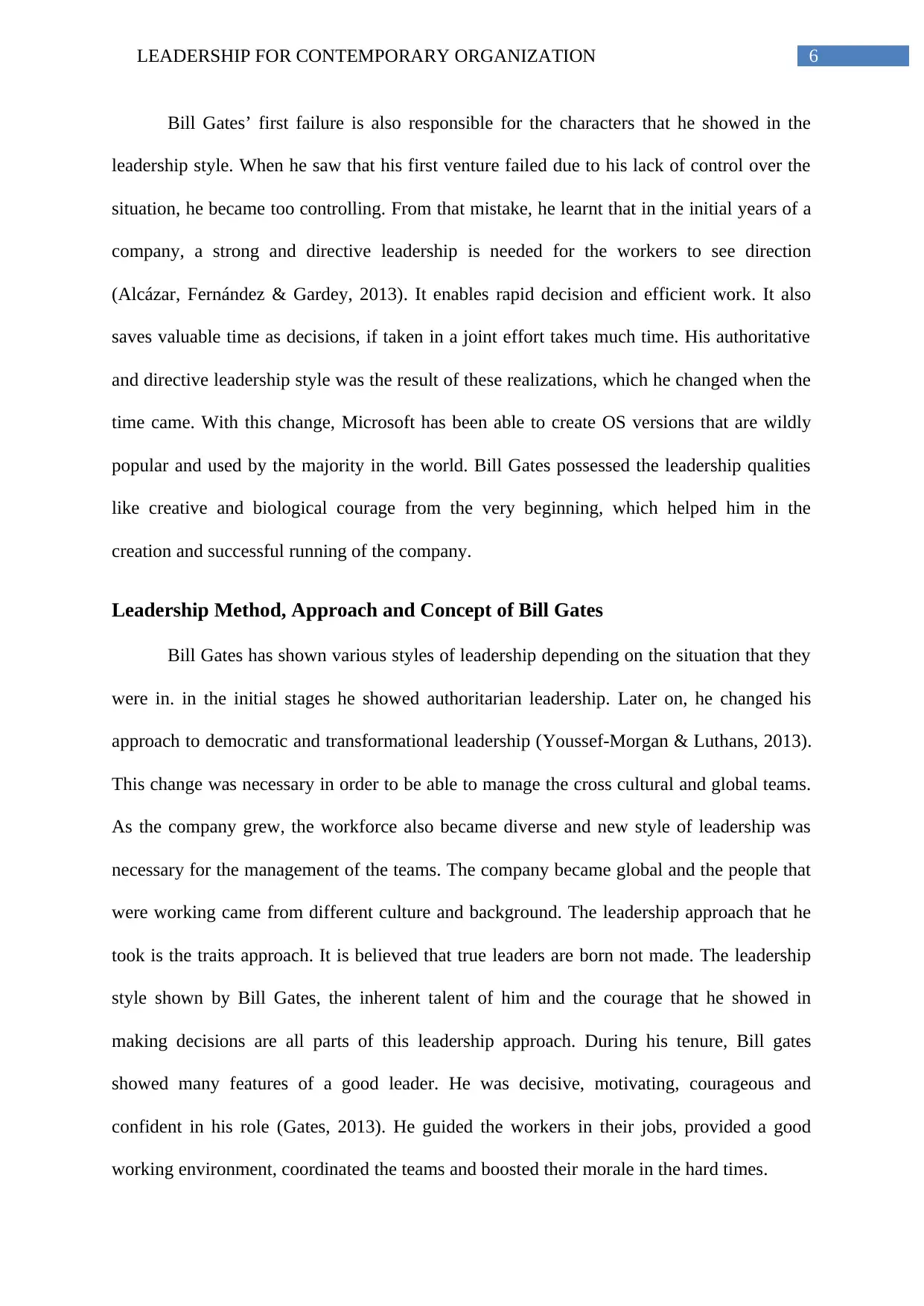
6LEADERSHIP FOR CONTEMPORARY ORGANIZATION
Bill Gates’ first failure is also responsible for the characters that he showed in the
leadership style. When he saw that his first venture failed due to his lack of control over the
situation, he became too controlling. From that mistake, he learnt that in the initial years of a
company, a strong and directive leadership is needed for the workers to see direction
(Alcázar, Fernández & Gardey, 2013). It enables rapid decision and efficient work. It also
saves valuable time as decisions, if taken in a joint effort takes much time. His authoritative
and directive leadership style was the result of these realizations, which he changed when the
time came. With this change, Microsoft has been able to create OS versions that are wildly
popular and used by the majority in the world. Bill Gates possessed the leadership qualities
like creative and biological courage from the very beginning, which helped him in the
creation and successful running of the company.
Leadership Method, Approach and Concept of Bill Gates
Bill Gates has shown various styles of leadership depending on the situation that they
were in. in the initial stages he showed authoritarian leadership. Later on, he changed his
approach to democratic and transformational leadership (Youssef-Morgan & Luthans, 2013).
This change was necessary in order to be able to manage the cross cultural and global teams.
As the company grew, the workforce also became diverse and new style of leadership was
necessary for the management of the teams. The company became global and the people that
were working came from different culture and background. The leadership approach that he
took is the traits approach. It is believed that true leaders are born not made. The leadership
style shown by Bill Gates, the inherent talent of him and the courage that he showed in
making decisions are all parts of this leadership approach. During his tenure, Bill gates
showed many features of a good leader. He was decisive, motivating, courageous and
confident in his role (Gates, 2013). He guided the workers in their jobs, provided a good
working environment, coordinated the teams and boosted their morale in the hard times.
Bill Gates’ first failure is also responsible for the characters that he showed in the
leadership style. When he saw that his first venture failed due to his lack of control over the
situation, he became too controlling. From that mistake, he learnt that in the initial years of a
company, a strong and directive leadership is needed for the workers to see direction
(Alcázar, Fernández & Gardey, 2013). It enables rapid decision and efficient work. It also
saves valuable time as decisions, if taken in a joint effort takes much time. His authoritative
and directive leadership style was the result of these realizations, which he changed when the
time came. With this change, Microsoft has been able to create OS versions that are wildly
popular and used by the majority in the world. Bill Gates possessed the leadership qualities
like creative and biological courage from the very beginning, which helped him in the
creation and successful running of the company.
Leadership Method, Approach and Concept of Bill Gates
Bill Gates has shown various styles of leadership depending on the situation that they
were in. in the initial stages he showed authoritarian leadership. Later on, he changed his
approach to democratic and transformational leadership (Youssef-Morgan & Luthans, 2013).
This change was necessary in order to be able to manage the cross cultural and global teams.
As the company grew, the workforce also became diverse and new style of leadership was
necessary for the management of the teams. The company became global and the people that
were working came from different culture and background. The leadership approach that he
took is the traits approach. It is believed that true leaders are born not made. The leadership
style shown by Bill Gates, the inherent talent of him and the courage that he showed in
making decisions are all parts of this leadership approach. During his tenure, Bill gates
showed many features of a good leader. He was decisive, motivating, courageous and
confident in his role (Gates, 2013). He guided the workers in their jobs, provided a good
working environment, coordinated the teams and boosted their morale in the hard times.
Paraphrase This Document
Need a fresh take? Get an instant paraphrase of this document with our AI Paraphraser

7LEADERSHIP FOR CONTEMPORARY ORGANIZATION
Through the change in his approach to leadership, he also showed his workforce that
he was willing to change if that meant improvement for the company. This created an
environment of change in the organization. Through effective people management strategies,
he made sure that he only hired people that were able and creative (Goleman, 2013). He
created a refined recruitment process in order to enable that. The company provides high
level training to competent employees and ensures that they are motivated to do their work.
Regular performance appraisals and promotions also provided motivation for the employees.
Due to the global presence of the organization, people also find employment in the
organization to be a profitable one. They also ensure employee engagement through other
processes (Fejerskov, 2015). Regular feedbacks and acting on them provides employees with
interest to be engaged in the organization.
Conclusion
From the above discussion, it can be concluded that leadership style, approach and
concepts are extremely necessary when it comes to managing a workforce in global scenario.
Well-known leaders like Bill Gates have achieved success through different methods of
leadership. It has been seen that leadership styles depend mainly on the personality and in-
born talent of the person. Successful leadership ensures enhancement of individual
performance. It also motivates the employees to organizational involvement and creates a
positive organizational culture.
Through the change in his approach to leadership, he also showed his workforce that
he was willing to change if that meant improvement for the company. This created an
environment of change in the organization. Through effective people management strategies,
he made sure that he only hired people that were able and creative (Goleman, 2013). He
created a refined recruitment process in order to enable that. The company provides high
level training to competent employees and ensures that they are motivated to do their work.
Regular performance appraisals and promotions also provided motivation for the employees.
Due to the global presence of the organization, people also find employment in the
organization to be a profitable one. They also ensure employee engagement through other
processes (Fejerskov, 2015). Regular feedbacks and acting on them provides employees with
interest to be engaged in the organization.
Conclusion
From the above discussion, it can be concluded that leadership style, approach and
concepts are extremely necessary when it comes to managing a workforce in global scenario.
Well-known leaders like Bill Gates have achieved success through different methods of
leadership. It has been seen that leadership styles depend mainly on the personality and in-
born talent of the person. Successful leadership ensures enhancement of individual
performance. It also motivates the employees to organizational involvement and creates a
positive organizational culture.
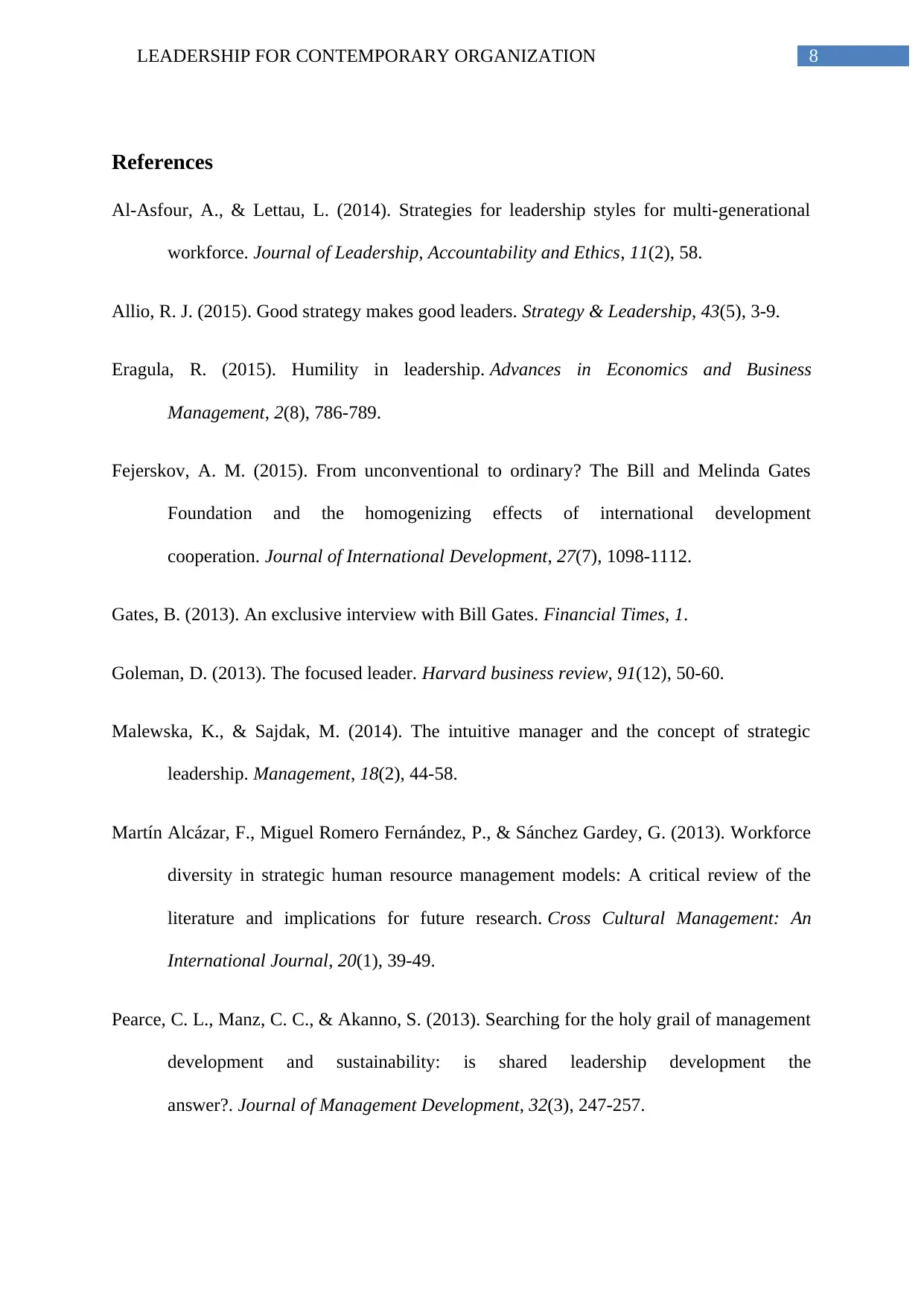
8LEADERSHIP FOR CONTEMPORARY ORGANIZATION
References
Al-Asfour, A., & Lettau, L. (2014). Strategies for leadership styles for multi-generational
workforce. Journal of Leadership, Accountability and Ethics, 11(2), 58.
Allio, R. J. (2015). Good strategy makes good leaders. Strategy & Leadership, 43(5), 3-9.
Eragula, R. (2015). Humility in leadership. Advances in Economics and Business
Management, 2(8), 786-789.
Fejerskov, A. M. (2015). From unconventional to ordinary? The Bill and Melinda Gates
Foundation and the homogenizing effects of international development
cooperation. Journal of International Development, 27(7), 1098-1112.
Gates, B. (2013). An exclusive interview with Bill Gates. Financial Times, 1.
Goleman, D. (2013). The focused leader. Harvard business review, 91(12), 50-60.
Malewska, K., & Sajdak, M. (2014). The intuitive manager and the concept of strategic
leadership. Management, 18(2), 44-58.
Martín Alcázar, F., Miguel Romero Fernández, P., & Sánchez Gardey, G. (2013). Workforce
diversity in strategic human resource management models: A critical review of the
literature and implications for future research. Cross Cultural Management: An
International Journal, 20(1), 39-49.
Pearce, C. L., Manz, C. C., & Akanno, S. (2013). Searching for the holy grail of management
development and sustainability: is shared leadership development the
answer?. Journal of Management Development, 32(3), 247-257.
References
Al-Asfour, A., & Lettau, L. (2014). Strategies for leadership styles for multi-generational
workforce. Journal of Leadership, Accountability and Ethics, 11(2), 58.
Allio, R. J. (2015). Good strategy makes good leaders. Strategy & Leadership, 43(5), 3-9.
Eragula, R. (2015). Humility in leadership. Advances in Economics and Business
Management, 2(8), 786-789.
Fejerskov, A. M. (2015). From unconventional to ordinary? The Bill and Melinda Gates
Foundation and the homogenizing effects of international development
cooperation. Journal of International Development, 27(7), 1098-1112.
Gates, B. (2013). An exclusive interview with Bill Gates. Financial Times, 1.
Goleman, D. (2013). The focused leader. Harvard business review, 91(12), 50-60.
Malewska, K., & Sajdak, M. (2014). The intuitive manager and the concept of strategic
leadership. Management, 18(2), 44-58.
Martín Alcázar, F., Miguel Romero Fernández, P., & Sánchez Gardey, G. (2013). Workforce
diversity in strategic human resource management models: A critical review of the
literature and implications for future research. Cross Cultural Management: An
International Journal, 20(1), 39-49.
Pearce, C. L., Manz, C. C., & Akanno, S. (2013). Searching for the holy grail of management
development and sustainability: is shared leadership development the
answer?. Journal of Management Development, 32(3), 247-257.
⊘ This is a preview!⊘
Do you want full access?
Subscribe today to unlock all pages.

Trusted by 1+ million students worldwide
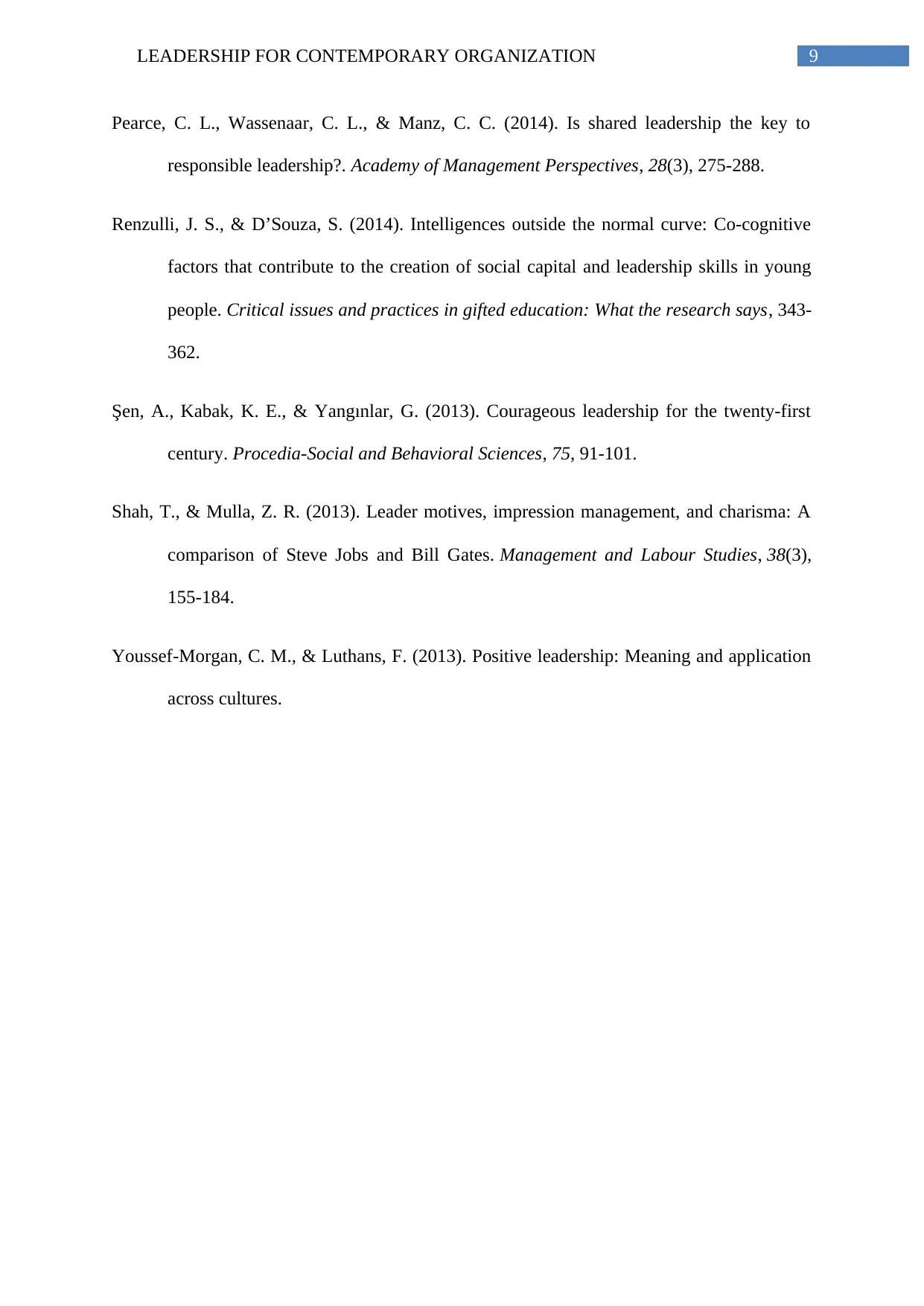
9LEADERSHIP FOR CONTEMPORARY ORGANIZATION
Pearce, C. L., Wassenaar, C. L., & Manz, C. C. (2014). Is shared leadership the key to
responsible leadership?. Academy of Management Perspectives, 28(3), 275-288.
Renzulli, J. S., & D’Souza, S. (2014). Intelligences outside the normal curve: Co-cognitive
factors that contribute to the creation of social capital and leadership skills in young
people. Critical issues and practices in gifted education: What the research says, 343-
362.
Şen, A., Kabak, K. E., & Yangınlar, G. (2013). Courageous leadership for the twenty-first
century. Procedia-Social and Behavioral Sciences, 75, 91-101.
Shah, T., & Mulla, Z. R. (2013). Leader motives, impression management, and charisma: A
comparison of Steve Jobs and Bill Gates. Management and Labour Studies, 38(3),
155-184.
Youssef-Morgan, C. M., & Luthans, F. (2013). Positive leadership: Meaning and application
across cultures.
Pearce, C. L., Wassenaar, C. L., & Manz, C. C. (2014). Is shared leadership the key to
responsible leadership?. Academy of Management Perspectives, 28(3), 275-288.
Renzulli, J. S., & D’Souza, S. (2014). Intelligences outside the normal curve: Co-cognitive
factors that contribute to the creation of social capital and leadership skills in young
people. Critical issues and practices in gifted education: What the research says, 343-
362.
Şen, A., Kabak, K. E., & Yangınlar, G. (2013). Courageous leadership for the twenty-first
century. Procedia-Social and Behavioral Sciences, 75, 91-101.
Shah, T., & Mulla, Z. R. (2013). Leader motives, impression management, and charisma: A
comparison of Steve Jobs and Bill Gates. Management and Labour Studies, 38(3),
155-184.
Youssef-Morgan, C. M., & Luthans, F. (2013). Positive leadership: Meaning and application
across cultures.
1 out of 10
Related Documents
Your All-in-One AI-Powered Toolkit for Academic Success.
+13062052269
info@desklib.com
Available 24*7 on WhatsApp / Email
![[object Object]](/_next/static/media/star-bottom.7253800d.svg)
Unlock your academic potential
Copyright © 2020–2025 A2Z Services. All Rights Reserved. Developed and managed by ZUCOL.





